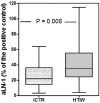Anti-laminin-1 antibodies in serum and follicular fluid of women with Hashimoto's thyroiditis undergoing in vitro fertilization
- PMID: 26813862
- PMCID: PMC5806718
- DOI: 10.1177/0394632015627281
Anti-laminin-1 antibodies in serum and follicular fluid of women with Hashimoto's thyroiditis undergoing in vitro fertilization
Abstract
The aim of this study is to evaluate the presence of anti-laminin-1 antibodies (aLN-1) in sera and follicular fluid (FF) of infertile women affected by Hashimoto's thyroiditis (HT) undergoing in vitro fertilization (IVF) and its impact on oocyte maturation and IVF outcome. aLN-1 were measured by a home-made enzyme linked immunosorbent assay (ELISA) in: (1) sera and FF from 44 infertile women affected by HT (HTIW) with tubal factor or male factor as primary cause of infertility; (2) in sera and FF from 28 infertile women without HT, with tubal factor or male factor as cause of infertility (infertile controls-ICTR); and (3) in sera from 50 fertile women (FW). aLN-1 serum levels were significantly higher in HTIW when compared with both fertile women and ICTR (P <0.001and P <0.01, respectively). Assuming as cutoff the 99th percentile of values obtained in sera of FW, 43.2% of HTIW and 3.6% of ICTR were aLN-1 positive (P = 0.0001). Also aLN-1 detected in FF from HTIW were significantly higher in comparison with those found in FF of ICTR (P = 0.006). In HTIW, metaphase II oocyte count showed inverse correlation with both serum and FF aLN-1 levels (r = 0.34, P = 0.02 and r = 0.33, P = 0.03, respectively). Implantation and pregnancy rates were significantly lower in HTIW (7.9% and 9.1%, respectively) when compared with ICTR (23% and 31.1%, respectively) (P = 0.015 and P = 0.03, respectively). Our results demonstrated for the first time the presence of aLN-1 in a relevant percentage of HTIW and suggest that these auto-antibodies may impair IVF outcome.
Keywords: Hashimoto’s thyroiditis; anti-laminin-1 Ab; in vitro fertilization (IVF) outcome.
© The Author(s) 2016.
Conflict of interest statement
Figures




Similar articles
-
Anti-laminin-1 antibodies in sera and follicular fluid of women with endometriosis undergoing in vitro fertilization.Int J Immunopathol Pharmacol. 2011 Apr-Jun;24(2):481-8. doi: 10.1177/039463201102400221. Int J Immunopathol Pharmacol. 2011. PMID: 21658322
-
Follicular fluid from infertile women with mild endometriosis may compromise the meiotic spindles of bovine metaphase II oocytes.Hum Reprod. 2014 Feb;29(2):315-23. doi: 10.1093/humrep/det378. Epub 2013 Oct 27. Hum Reprod. 2014. PMID: 24166595
-
Relationship between resistin and IL-23 levels in follicular fluid in infertile patients with endometriosis undergoing IVF-ET.Adv Clin Exp Med. 2017 Dec;26(9):1431-1435. doi: 10.17219/acem/41149. Adv Clin Exp Med. 2017. PMID: 29442466
-
Follicular fluid levels of anti-Mullerian hormone as a predictor of oocyte maturation, fertilization rate, and embryonic development in patients with polycystic ovary syndrome.Fertil Steril. 2010 May 1;93(7):2299-302. doi: 10.1016/j.fertnstert.2009.01.125. Epub 2009 Mar 3. Fertil Steril. 2010. PMID: 19261276 Clinical Trial.
-
Follicular Fluid Metabolomics: Tool for Predicting IVF Outcomes of Different Infertility Causes.Reprod Sci. 2025 Apr;32(4):921-934. doi: 10.1007/s43032-024-01664-y. Epub 2024 Aug 1. Reprod Sci. 2025. PMID: 39090336 Free PMC article. Review.
Cited by
-
B cells from anti-thyroid antibody positive, infertile women show hyper-reactivity to BCR stimulation.Front Immunol. 2022 Oct 25;13:1039166. doi: 10.3389/fimmu.2022.1039166. eCollection 2022. Front Immunol. 2022. PMID: 36389812 Free PMC article.
-
Update on the pathogenesis of endometriosis-related infertility based on contemporary evidence.Front Endocrinol (Lausanne). 2025 Mar 10;16:1558271. doi: 10.3389/fendo.2025.1558271. eCollection 2025. Front Endocrinol (Lausanne). 2025. PMID: 40130159 Free PMC article. Review.
-
The efficacy of acupuncture for the treatment and the fertility improvement in child-bearing period female with Hashimoto Disease: A randomized controlled study.Medicine (Baltimore). 2020 Jul 2;99(27):e20909. doi: 10.1097/MD.0000000000020909. Medicine (Baltimore). 2020. PMID: 32629685 Free PMC article. Clinical Trial.
-
Should we routinely assess ovarian reserve in girls and young women with autoimmune thyroid disease?Heliyon. 2024 Nov 5;10(22):e40156. doi: 10.1016/j.heliyon.2024.e40156. eCollection 2024 Nov 30. Heliyon. 2024. PMID: 39634384 Free PMC article.
-
The Impact of Autoantibodies on IVF Treatment and Outcome: A Systematic Review.Int J Mol Sci. 2019 Feb 19;20(4):892. doi: 10.3390/ijms20040892. Int J Mol Sci. 2019. PMID: 30791371 Free PMC article.
References
-
- Poppe K, Glinoer D. (2003) Thyroid autoimmunity and hypothyroidism before and during pregnancy. Human Reproduction Update 9: 149–161. - PubMed
-
- Tartakover-Matalon S, Blank M, Ornoy A, et al. (2001) The association between anti-thyroid antibodies and pregnancy loss. American Journal of Reproductive Immunology 45: 72–77. - PubMed
-
- Stagnaro-Green A, Glinoer D. (2004) Thyroid autoimmunity and the risk of miscarriage. Best Practice & Research Clinical Endocrinology & Metabolism 18: 167–181. - PubMed
-
- Poppe K, Velkeniers B, Glinoer D. (2008) The role of thyroid autoimmunity in infertility and pregnancy. Nature Clinical Practice Endocrinology & Metabolism 4: 394–405. - PubMed
-
- Van den Boogaard E, Vissenberg R, Land JA, et al. (2011) Significance of (sub) clinical thyroid dysfunction and thyroid autoimmunity before conception and in early pregnancy: A systematic review. Human Reproduction Update 17: 605–619. - PubMed
Publication types
MeSH terms
Substances
LinkOut - more resources
Full Text Sources
Other Literature Sources

